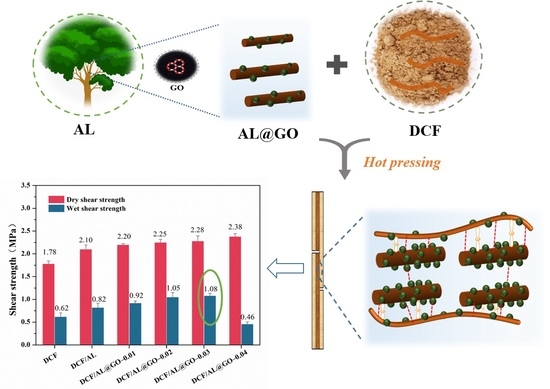Graphene Oxide Functionalized Cottonseed-Lignin Resin with Enhanced Wet Adhesion for Woody Composites Application
Abstract
:1. Introduction
2. Materials and Methods
2.1. Materials
2.2. Adhesives Preparation
2.3. FTIR Analysis
2.4. TG Analysis
2.5. SEM Analysis
2.6. Sol-Gel Analysis
2.7. Rheological Analysis
2.8. Wet Adhesion Analysis
3. Results and Discussion
3.1. Characterization
3.2. Sol-Gel Test
3.3. Rheology Properties
3.4. Adhesiveness
4. Conclusions
Author Contributions
Funding
Institutional Review Board Statement
Informed Consent Statement
Data Availability Statement
Conflicts of Interest
References
- Li, J.; Pradyawong, S.; He, Z.Q.; Sun, X.Z.S.; Wang, D.H.; Cheng, H.N.; Zhong, J.Y. Assessment and application of phosphorus/calcium-cottonseed protein adhesive for plywood production. J. Clean. Prod. 2019, 229, 454–462. [Google Scholar] [CrossRef]
- Xu, C.J.; Xu, Y.C.; Chen, M.S.; Zhang, Y.; Li, J.Z.; Gao, Q.; Shi, S.Q. Soy protein adhesive with bio-based epoxidized daidzein for high strength and mildew resistance. Chem. Eng. J. 2020, 390, 124622. [Google Scholar] [CrossRef]
- Chen, N.; Huang, J.; Li, K.J.H. Investigation of a new formaldehyde-free adhesive consisting of soybean flour and Kymene® 736 for interior plywood. Holzforschung 2018, 73, 409–414. [Google Scholar] [CrossRef]
- Zhao, S.; Wang, Z.; Li, Z.; Li, L.; Li, J.; Zhang, S. Core-Shell Nanohybrid Elastomer Based on Co-Deposition Strategy to Improve Performance of Soy Protein Adhesive. ACS Appl. Mater. Interfaces 2019, 11, 32414–32422. [Google Scholar] [CrossRef]
- Cheng, H.N.; Dowd, M.K.; He, Z.Q. Investigation of modified cottonseed protein adhesives for wood composites. Ind. Crops Prod. 2013, 46, 399–403. [Google Scholar] [CrossRef]
- He, Z.Q.; Hailin, Z.; Olk, D.C.; Mark, S.; Way, T.R.; Haile, T.J. Protein and Fiber Profiles of Cottonseed from Upland Cotton with Different Fertilizations. Mod. Appl. Sci. 2014, 8, 97–105. [Google Scholar] [CrossRef] [Green Version]
- Chen, N.R.; Huang, J.; Li, K.C. Investigation of a Formaldehyde-free Cottonseed Flour-based Adhesive for Interior Plywood. Bioresources 2020, 15, 5546–5557. [Google Scholar] [CrossRef]
- Zhao, S.; Abu-Omar, M.M. Synthesis of Renewable Thermoset Polymers through Successive Lignin Modification using Lignin-Derived Phenols (LDPs). ACS Sustain. Chem. Eng. 2017, 5, 5059–5066. [Google Scholar] [CrossRef]
- Luo, J.; Yuan, C.; Zhang, W.; Li, J.; Gao, Q. An eco-friendly wood adhesive from soy protein and lignin: Performance properties. RSC Adv. 2015, 5, 100849–100855. [Google Scholar] [CrossRef]
- Chen, S.L.; Wang, G.H.; Sui, W.J.; Parvez, A.M.; Si, C.L. Synthesis of lignin-functionalized phenolic nanosphere supported Ag nanoparticles with excellent dispersion stability and catalytic performance. Green Chem. 2020, 22, 2879–2888. [Google Scholar] [CrossRef]
- Zhang, Y.; Wu, J.Q.; Li, H.; Yuan, T.Q.; Wang, Y.Y.; Sun, R.C. Heat Treatment of Industrial Alkaline Lignin and its Potential Application as an Adhesive for Green Wood-Lignin Composites. ACS Sustain. Chem. Eng. 2017, 5, 7269–7277. [Google Scholar] [CrossRef]
- Gioia, C.; Lo Re, G.; Lawoko, M.; Berglund, L. Tunable Thermosetting Epoxies Based on Fractionated and Well-Characterized Lignins. J. Am. Chem. Soc. 2018, 140, 4054–4061. [Google Scholar] [CrossRef] [Green Version]
- Luo, X.; Liu, J.; Zheng, P.; Li, M.; Zhou, Y.; Huang, L.; Chen, L.; Shuai, L. Promoting enzymatic hydrolysis of lignocellulosic biomass by inexpensive soy protein. Biotechnol. Biofuels 2019, 12, 51. [Google Scholar] [CrossRef] [Green Version]
- Zheng, P.; Xiang, L.; Chang, J.; Lin, Q.; Xie, L.; Lan, T.; Liu, J.; Gong, Z.; Tang, T.; Shuai, L.; et al. Nanomechanics of Lignin-Cellulase Interactions in Aqueous Solutions. Biomacromolecules 2021, 22, 2033–2042. [Google Scholar] [CrossRef] [PubMed]
- Xiao, Z.G.; Li, Y.H.; Wu, X.R.; Qi, G.Y.; Li, N.B.; Zhang, K.; Wang, D.H.; Sun, X.Z.S. Utilization of sorghum lignin to improve adhesion strength of soy protein adhesives on wood veneer. Ind. Crops Prod. 2013, 50, 501–509. [Google Scholar] [CrossRef]
- Wang, W.; Xu, G. Effects of Soy-adhesive/PF Mixture on Shear Strength of Plywood. J. Northeast For. Univ. 2007, 2, 910–931. [Google Scholar]
- Dreyer, D.R.; Park, S.; Bielawski, C.W.; Ruoff, R.S. The chemistry of graphene oxide. Chem. Soc. Rev. 2010, 39, 228–240. [Google Scholar] [CrossRef] [PubMed]
- Agarwal, V.; Zetterlund, P.J. Strategies for reduction of graphene oxide—A comprehensive review. Chem. Eng. J. 2020, 405, 127018. [Google Scholar] [CrossRef]
- Gu, W.D.; Liu, X.R.; Li, F.; Shi, S.Q.; Li, J.Z. Tough, strong, and biodegradable composite film with excellent UV barrier performance comprising soy protein isolate, hyperbranched polyester, and cardanol derivative. Green Chem. 2019, 21, 3651–3665. [Google Scholar] [CrossRef]
- Li, J.J.; Luo, J.; Li, X.N.; Yi, Z.; Gao, Q.; Li, J.Z. Soybean meal-based wood adhesive enhanced by ethylene glycol diglycidyl ether and diethylenetriamine. Ind. Crops Prod. 2015, 74, 613–618. [Google Scholar] [CrossRef]
- Qi, G.; Sun, X.S. Soy Protein Adhesive Blends with Synthetic Latex on Wood Veneer. J. Am. Oil Chem. Soc. 2011, 88, 271–281. [Google Scholar] [CrossRef]
- Yi, Z.; Meng, Z.; Chen, M.; Jing, L.; Li, X.; Qiang, G.; Li, J.J. Preparation and characterization of a soy protein–based high-performance adhesive with a hyperbranched cross-linked structure. Chem. Eng. J. 2018, 354, 1032–1041. [Google Scholar]
- Yin, H.; Zhang, E.B.; Zhu, Z.Q.; Han, L.B.; Zheng, P.T.; Zeng, H.B.; Chen, N.R. Soy-Based Adhesives Functionalized with Pressure-Responsive Crosslinker Microcapsules for Enhanced Wet Adhesion. ACS Appl. Polym. Mater. 2021, 3, 1032–1041. [Google Scholar] [CrossRef]
- Chen, N.R.; Lin, Q.J.; Rao, J.P.; Zeng, Q.Z. Water resistances and bonding strengths of soy-based adhesives containing different carbohydrates. Ind. Crops Prod. 2013, 50, 44–49. [Google Scholar] [CrossRef]
- Ghosh Dastidar, T.; Netravali, A.N. A soy flour based thermoset resin without the use of any external crosslinker. Green Chem. 2013, 15, 3243–3251. [Google Scholar] [CrossRef]
- Chen, N.R.; Zeng, Q.Z.; Lin, Q.J.; Rao, J.P. Development of defatted soy flour based bio-adhesives using Viscozyme L. Ind. Crops Prod. 2015, 76, 198–203. [Google Scholar] [CrossRef]
- Zeng, Y.; Xu, P.; Yang, W.; Chu, H.; Ma, P. Soy protein-based adhesive with superior bonding strength and water resistance by designing densely crosslinking networks. Eur. Polym. J. 2020, 142, 110128. [Google Scholar] [CrossRef]
- Arshad, M.; Maali, A.; Claudet, C.; Lobry, L.; Peters, F.; Lemaire, E. An experimental study on the role of inter-particle friction in the shear-thinning behavior of non-Brownian suspensions. Soft Matter 2021, 17, 6088–6097. [Google Scholar] [CrossRef]
- Yin, H.; Zheng, P.T.; Zhang, E.B.; Rao, J.P.; Lin, Q.J.; Fan, M.Z.; Zhu, Z.Q.; Chen, M.Q.; Cheng, S.Y.; Zeng, Q.Z.; et al. An environmentally-friendly soybean based resin as an alternative to formaldehyde-based counterpart for biomass composites. Int. J. Adhes. Adhes. 2021, 104, 102755. [Google Scholar] [CrossRef]
- Zheng, P.; Chen, N.; Islam, S.; Ju, L.K.; Liu, J.; Zhou, J.; Chen, L.; Zeng, H.; Lin, Q.J. Development of Self-Cross-Linked Soy Adhesive by Enzyme Complex from Aspergillus niger for Production of All-Biomass Composite Materials. ACS Sustain. Chem. Eng. 2018, 7, 3909–3916. [Google Scholar] [CrossRef]
- Zhang, Y.; Shi, R.; Xu, Y.; Chen, M.; Zhang, J.; Gao, Q.; Li, J. Developing a stable high-performance soybean meal-based adhesive using a simple high-pressure homogenization technology. J. Clean. Prod. 2019, 256, 120336. [Google Scholar] [CrossRef]
- Luo, J.; Zhou, Y.; Gao, Q.; Li, J.Z.; Yan, N. From Wastes to Functions: A New Soybean Meal and Bark-Based Adhesive. ACS Sustain. Chem. Eng. 2020, 8, 10767–10773. [Google Scholar] [CrossRef]
- Berman, D.; Erdemir, A.; Sumant, A.V. Few layer graphene to reduce wear and friction on sliding steel surfaces. Carbon 2013, 54, 454. [Google Scholar] [CrossRef]


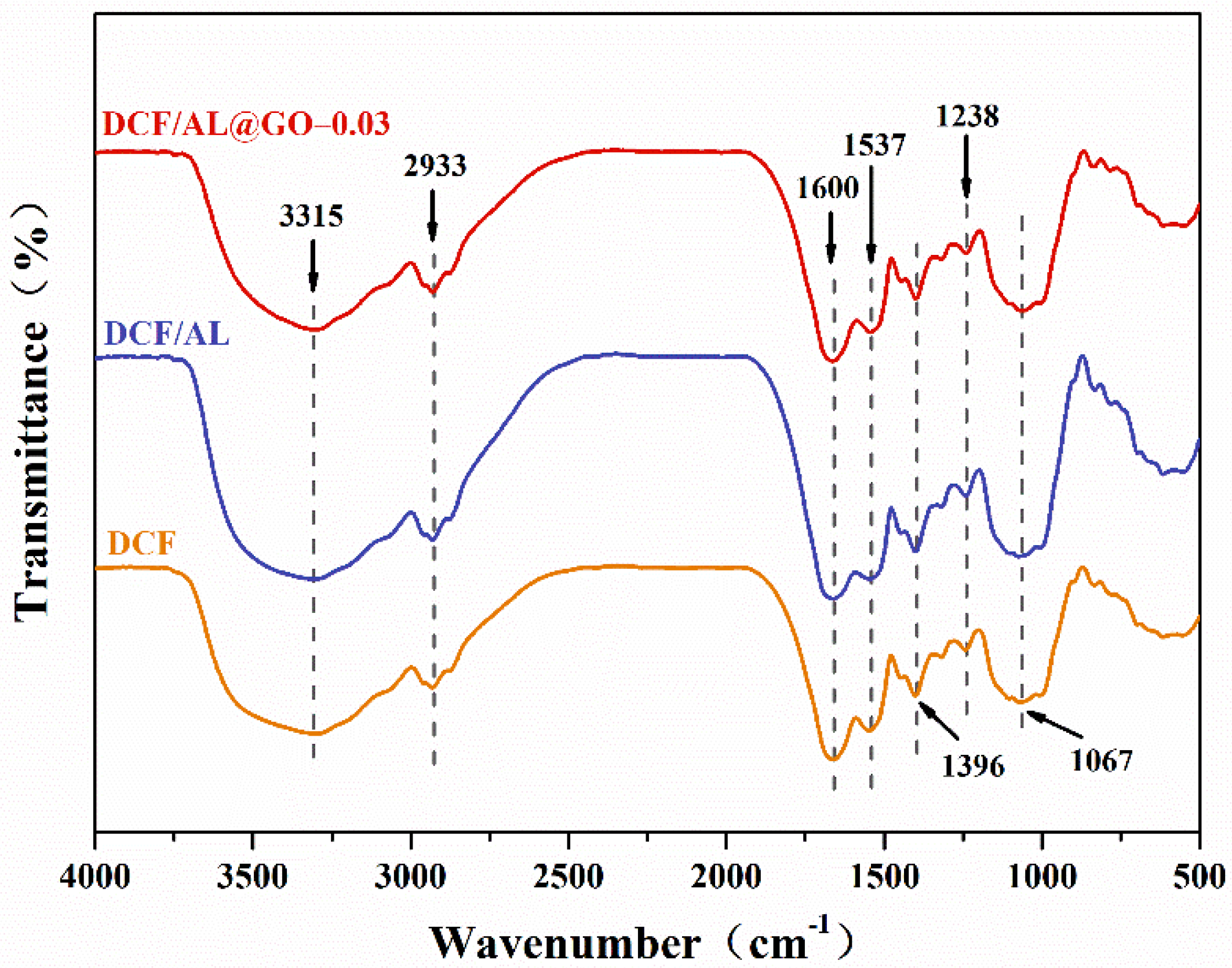
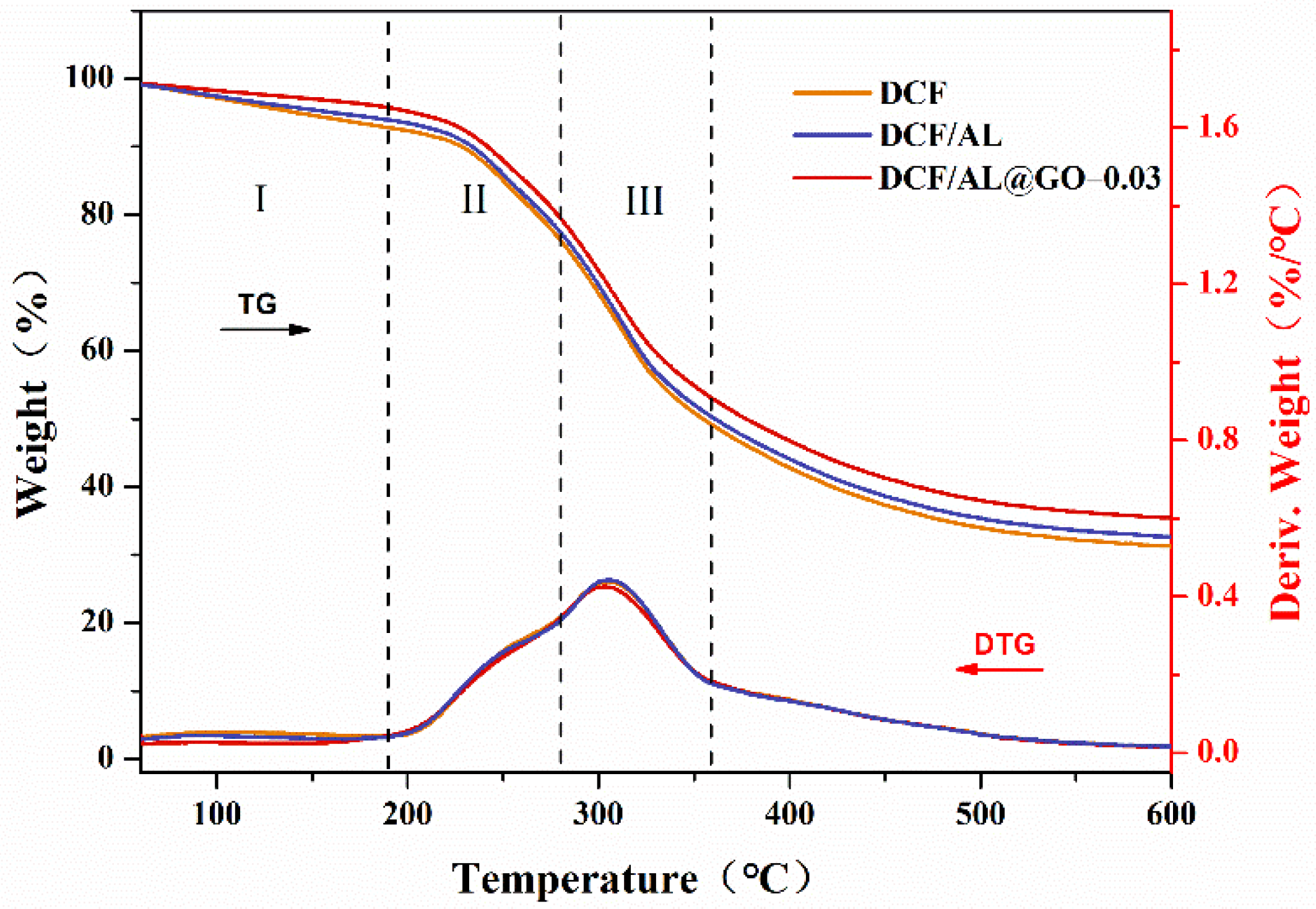

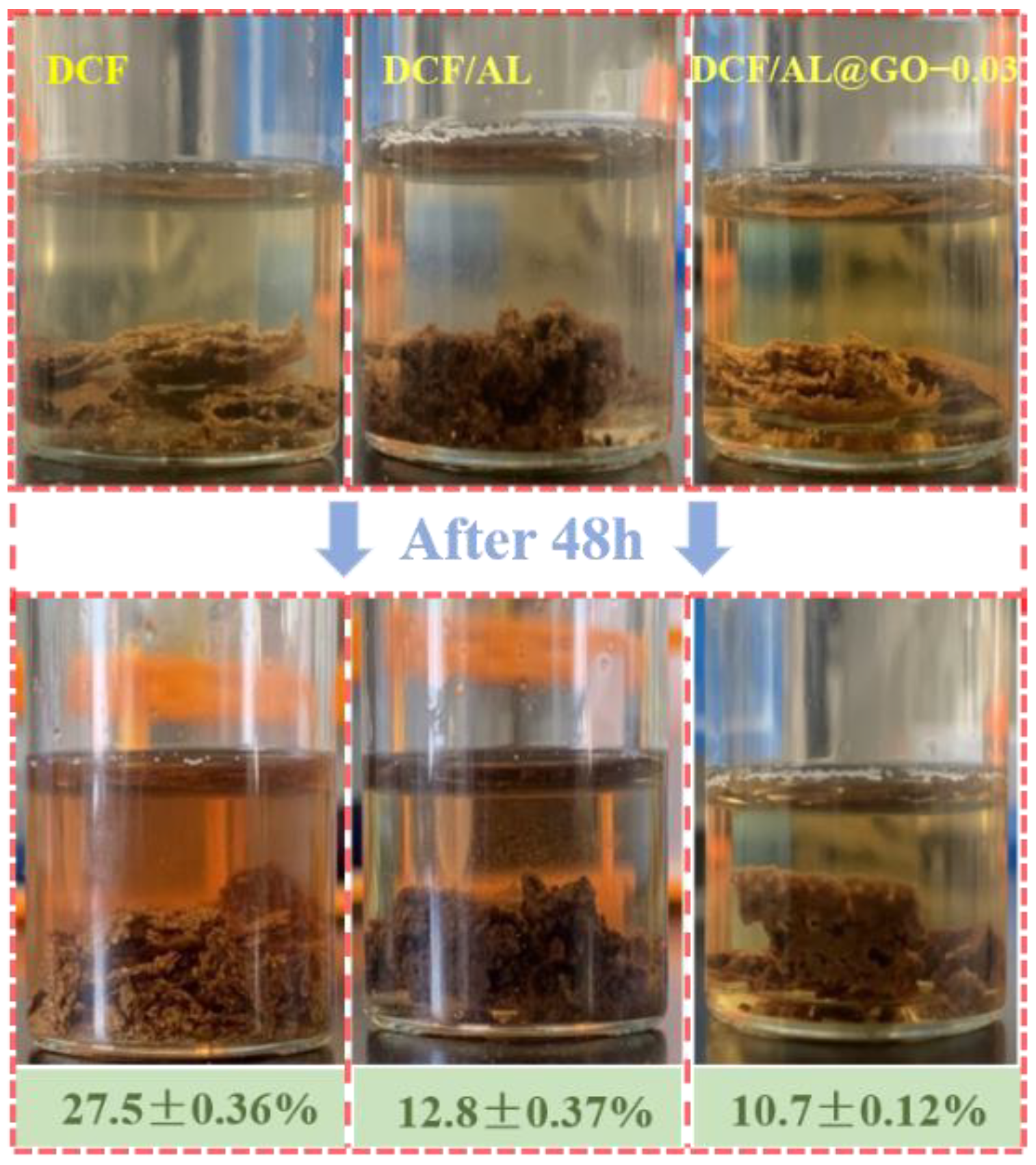
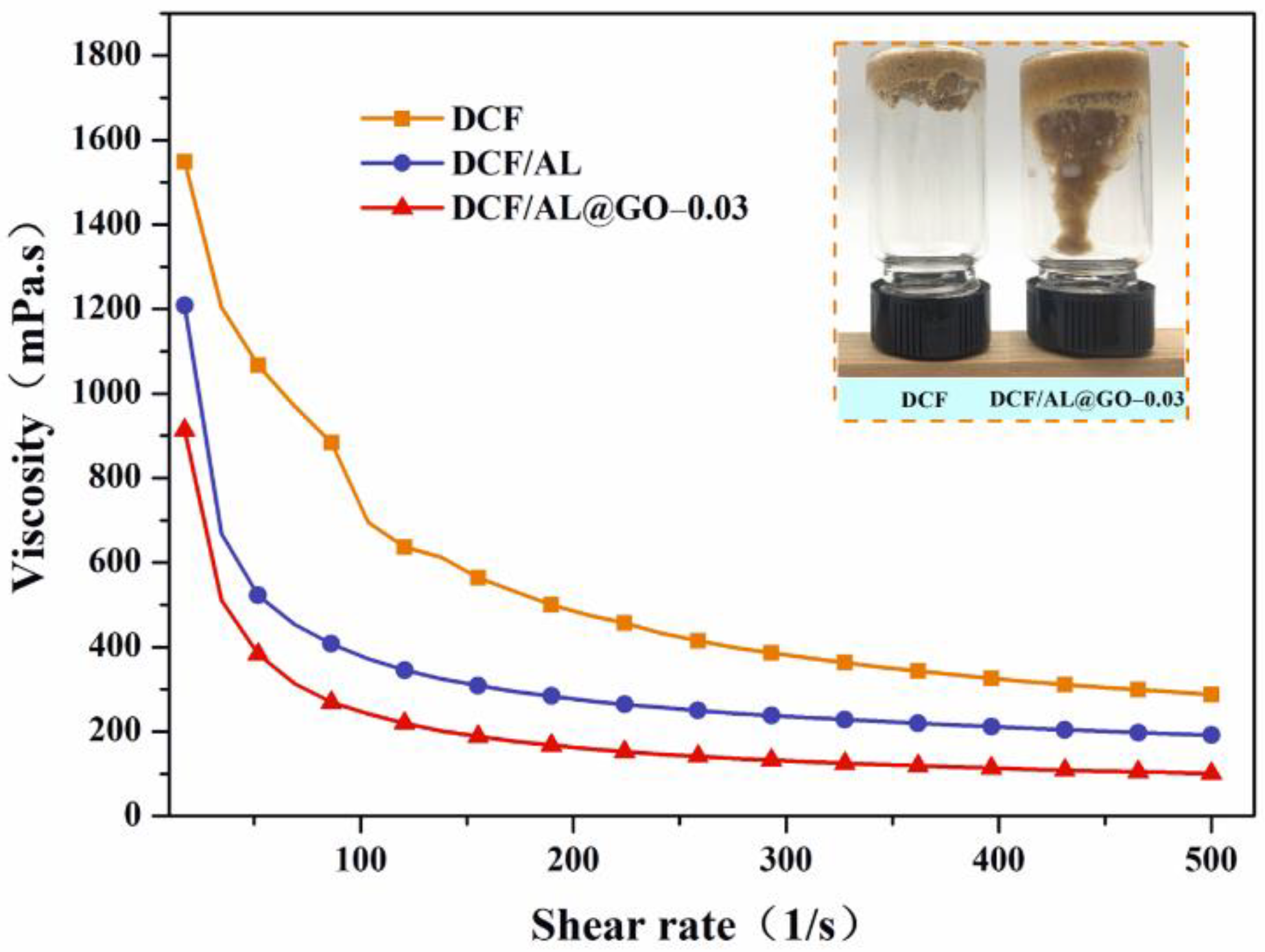

Publisher’s Note: MDPI stays neutral with regard to jurisdictional claims in published maps and institutional affiliations. |
© 2021 by the authors. Licensee MDPI, Basel, Switzerland. This article is an open access article distributed under the terms and conditions of the Creative Commons Attribution (CC BY) license (https://creativecommons.org/licenses/by/4.0/).
Share and Cite
Zhu, Z.; Zhang, E.; Zeng, Q.; Rao, J.; Chen, N. Graphene Oxide Functionalized Cottonseed-Lignin Resin with Enhanced Wet Adhesion for Woody Composites Application. Polymers 2022, 14, 1. https://doi.org/10.3390/polym14010001
Zhu Z, Zhang E, Zeng Q, Rao J, Chen N. Graphene Oxide Functionalized Cottonseed-Lignin Resin with Enhanced Wet Adhesion for Woody Composites Application. Polymers. 2022; 14(1):1. https://doi.org/10.3390/polym14010001
Chicago/Turabian StyleZhu, Zhiqiang, Erbing Zhang, Qinzhi Zeng, Jiuping Rao, and Nairong Chen. 2022. "Graphene Oxide Functionalized Cottonseed-Lignin Resin with Enhanced Wet Adhesion for Woody Composites Application" Polymers 14, no. 1: 1. https://doi.org/10.3390/polym14010001





